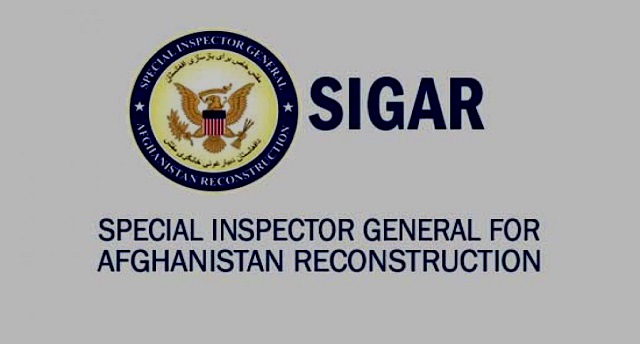May 03, 2021
SIGAR (Special Inspector General to Afghan Reconstruction) issued its 51st Quarterly Report to the Congress for the first quarter of 2021. The report summarizes SIGAR’s oversight work and updates developments in four major areas of reconstruction efforts in Afghanistan from January 1 to March 31, 2021. It also highlights SIGAR’s productivity and accomplishments in the mentioned period.
Key Points from the Report
— While violence is typically low in the first quarter of the calendar year (January-March), enemy-initiated attacks (EIA) from January 1-March 31, 2021 increased nearly 37% compared to the same quarter last year. However, EIA decreased by approximately 10% compared to last quarter (October 1-December 31, 2020).
— Both NATO Resolute Support (RS) and the United Nations Assistance Mission in Afghanistan (UNAMA) recorded strikingly high civilian casualties during January-March 2021, compared to the same period last year. According to UNAMA, civilian casualties increased by 29% this quarter (January 1-March 31, 2021) compared to the same period last year, after lower than usual civilian casualties during most of 2020.
— Between January 1-March 31, RS reported 2,038 civilian casualties, which included 643 deaths and 1,395 injuries. 93% of civilian casualties were attributed to antigovernment forces (61% to the Taliban, 29% to unknown insurgents, 3% to Islamic State-Khorasan, and less than 1% to the Haqqani Network).
— As a whole, total civilian casualties in the fourth quarter increased from the previous quarter for the first time since UNAMA’s systematic documentation began in 2009. UNAMA reported 1,748 civilian casualties this quarter (January 1-March 31), which included 572 deaths and 1,210 injuries.
— Afghan National Defense and Security Forces (ANDSF) casualties between January 1-March 31, 2021 were substantially higher than during the same period last year, but slightly lower than those between October-December 2020, according to U.S. Forces-Afghanistan (USFOR-A).
— The number of insider attacks on ANDSF personnel increased by 82% this quarter, compared to the same period last year (resulting in more than double the casualties from insider attacks). The Combined Security Transition Command-Afghanistan (CSTC-A) reported 31 insider attacks from January 1-April 1, resulting in 115 ANDSF personnel killed and 39 wounded.
— The ASSF conducted 67% more deliberate offensive operations this quarter compared to last quarter, according to NATO Special Operations Component Command-Afghanistan (NSOCC-A). 91% of ANDSF operations this quarter were conducted independently of U.S. and Coalition advisor support or accompaniment, according to NSOCC-A. This is well above the percentage of independent operations (53%) for the same period last year.
— As of April 2021, there are 16,832 Department of Defense contractor personnel supporting agency operations in Afghanistan. This includes 6,147 U.S. citizens, 6,399 third-country nationals, and 4,286 Afghan nationals. It is unclear who, if anyone, will replace them or perform their work after their withdrawal.
— Without continued contractor support, none of the Afghan Air Force’s (AFF) airframes can be sustained as combat effective for more than a few months, depending on the stock of equipment parts in-country, the maintenance capability on each airframe, and when contractor support is withdrawn, according to Train, Advise, and Assist Command-Air (TAAC-Air).
— DOD contractors provide maintenance services for ANDSF ground vehicles and train ANDSF technicians under the 2018 National Maintenance Strategy-Ground Vehicle Support (NMS-GVS) contract. CSTC-A reported this quarter that although the ANDSF dramatically improved its share of the work, it is still falling well below benchmarks for its share of the maintenance work orders they—rather than contractors— are supposed to perform.
— The number of Afghans requiring humanitarian assistance in 2021 has reached approximately half of Afghanistan’s total estimated population due to the health and socioeconomic impact of the COVID-19 pandemic, according to the United Nations. This figure is nearly double that of 2020, and a six-fold increase compared to four years ago.
— As many as 17 million Afghans, or approximately 42% of the estimated population, will likely face famine conditions during the upcoming year as a result of drought, according to the International Organization on Migration.
— 16.9 million people in Afghanistan are facing “crisis” and “emergency” levels of food insecurity, including 5.5 million people experiencing “emergency” levels – the second highest in the world, according to the UN. Almost half of Afghanistan’s children under five years old are projected to face acute malnutrition in 2021.
— In the first two quarters of 2021 child mortality rates in Afghanistan more than doubled compared to 2020, according to the United Nations Children’s Fund. Child mortality rates increased by 2.7%, neonatal mortality by 3.6%, and maternal deaths by 3.6% during this period.
Courtesy: SIGAR
Read Full Report at: https://www.sigar.mil/pdf/quarterlyreports/2021-04-30qr.pdf








